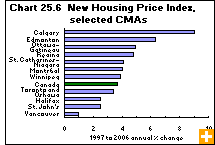Common menu bar links
Going like a house on fire
Archived Content
Information identified as archived is provided for reference, research or recordkeeping purposes. It is not subject to the Government of Canada Web Standards and has not been altered or updated since it was archived. Please contact us to request a format other than those available.
A strong economy, a steady influx of immigrants, and baby boomers spending more and more of their inheritance money has heated up the Canadian housing market over the last few years. As a result, the average cost of new homes has increased by nearly half since 1997.
The booming economy in Alberta and strong markets in the other prairie provinces account for a large part of the overall price rise. The New Housing Price Index (NHPI), which measures changes in contractors’ selling prices for new residential houses, shows that, as of December 2006, housing prices in Calgary and Edmonton had more than doubled since 1997, the base year of the index. New house prices in Regina, Winnipeg and Saskatoon have grown by half or more over that same period.The NHPI (1997=100) for Canada was at 147.5 in December 2006—not quite matching the boom in Alberta but a 48% jump in prices over 10 years nonetheless. Montréal, Ottawa–Gatineau and St. Catharines–Niagara all roughly tracked with this national average.
But the heat in some regions has not been felt in others. New house prices in Prince Edward Island and New Brunswick have climbed around 15% since 1997, and prices have edged up just 4% in Windsor, Ont., which has seen a downturn in its economy because of the slumping automotive sector.
Besides continued strong demand for new houses, the NHPI has been pushed up by steadily growing costs of building materials, such as copper, drywall, concrete and windows, as well as labour and land costs.



